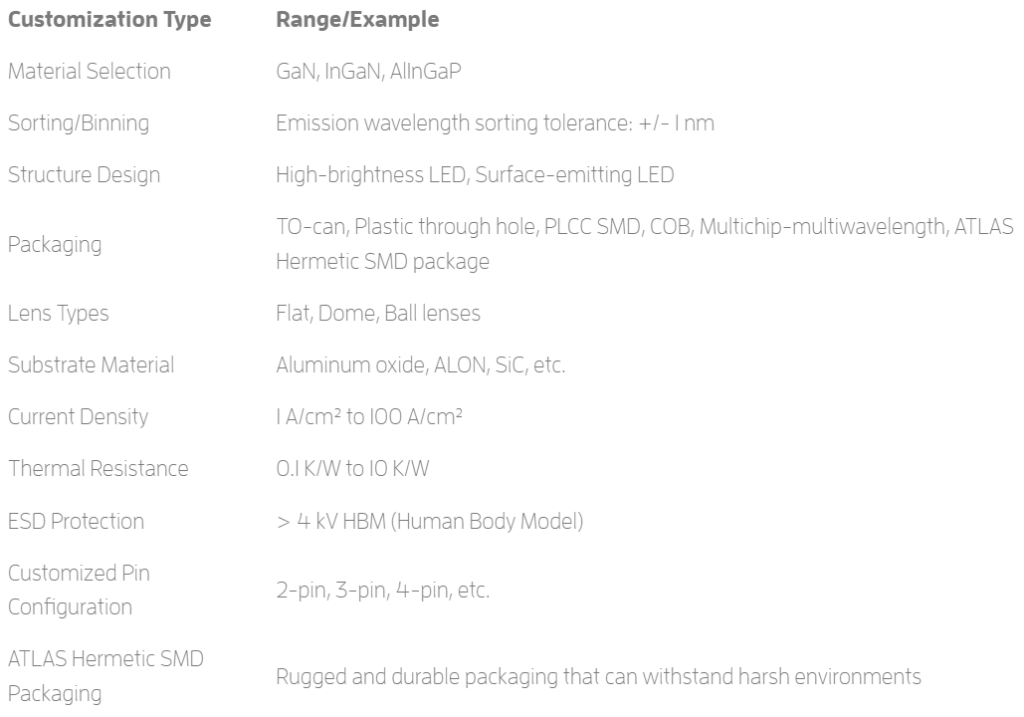Marktech Optoelectronics
3 Northway Lane North
Latham, NY 12110
Fax: +1-785-4725
Email: in**@ma**********.com
The broadest line of both silicon and InGaAs detectors commercially available.
Indium Gallium Arsenide (InGaAs) PIN photodiodes are made using InGaAs/InP technology.
Cutting-edge silicon photodetectors that excel in precise detection of light ranging in wavelength from 250nm to 1100nm
Monolithic “quads” or quadrant photodiodes (QPDs) are 2 X 2 photodiode arrays with four planar diffused photodiode elements or segments.
Marktech offers a broad line of silicon photo Transistors in a variety of package types ranging from miniature metal can to ceramic packages.
Our High-Reliability Photoreflectors are sensors that contain both the LED emitter and photodetector functions within a single package.
Marktech Si APD’s offer low-level light and short pulse detections of wavelengths between 400 nm and 1100 nm.
UV detectors are offered in a variety of TO metal-can type packages from TO-18 to TO-39 with special UV glass lens to insure optimum lifetime and the least amount of material degradation
With the ability to detect light in the UV, visible, and infrared spectrums, photo detectors, photo transistors, and photodiodes are being used in increasingly more applications.
Marktech offers the broadest range of emitters commercially available ranging from 235nm to 4300nm across the UV, visible, NIR, SWIR, and MWIR spectral ranges.
Marktech offers the broadest range of UV LEDs commercially available ranging from 235nm to 400nm including UVA, UVB, UVC, and deep UVC LEDs.
Our advanced line of visible LED products is engineered to deliver high-quality, energy-efficient lighting solutions across various applications from 400nm to 700nm..
Our NIR LED wavelength range is typically from 700nm to 1000nm, extending into wavelengths invisible to the human eye but crucial for numerous technological and scientific applications.
Our standard product offering includes wavelengths from 1020nm to 3000nm and operating currents ranging from 20mA to 350mA for high-power applications.
Our Point Source LEDs are specifically engineered for optical encoders, edge sensors, and other critical applications that demand highly focused light with minimal dispersion.
Multi-LED chips in a single package, our multiple wavelength LEDs are engineered to address a myriad of applications across the UV, visible, NIR, SWIR, and MWIR spectral ranges
Designed to produce a highly defined red dot or reticle, facilitating accurate aiming without revealing the location to the target.
Ideally suited for applications including edge sensing, line sensing, coin bill validation, and bar code reading
Our panels are crafted to deliver uniform, vibrant illumination across a wide range of applications, from consumer electronics to industrial displays.
Crafted with the latest LED technology, these rings provide adjustable illumination to meet specific needs, ensuring optimal visibility and enhancing the quality of your projects.
As a proud CREE LED Solution Provider for over a decade, Marktech offers comprehensive engineering support, including design, binning, and material selection, alongside custom packaging options for specialized applications.
CREE LED through-hole emitters, designed for high-temperature and moisture environments with UV-resistant optical-grade epoxy, offer a range of colors for versatile applications in signage and lighting.
CREE High Brightness (HB) SMD LEDs are the brightest, most reliable architectural, video, signage, scoreboard, roadway, and specialty LEDs available today.
CREE LED’s P4 series represents a leap in LED design, combining efficiency with aesthetic versatility to meet the demands of modern lighting applications.
Marktech’s CREE LED XLamp® offerings on aluminum core starboards simplify LED integration for designers, providing a range of colors and angles on compact boards for easy testing and implementation in varied lighting applications.
Marktech Optoelectronics introduces its new product line of CREE LED die, including the EZ1350 Series Die, packaged in TO-cans (TO-18 and TO-39 outlines) designed for precision and reliability in demanding applications with protection against environmental factors like moisture and dust.
Marktech Optoelectronics combines over 40 years of expertise in optoelectronics with a focus on customized engineering solutions, addressing specific customer needs and applications.
Custom photodiode detectors are designed to meet unique customer requirements, offering specialized performance features and cost savings through optimizations such as integrated filters, photodiode arrays, and hybridization.
Through our vertically integrated manufacturing facilities in California and Japan, we offer custom LED solutions, including packaging and optoelectrical categorization, enhancing product design and market readiness.
Multiple LED dies combined in a single package are engineered to address various applications across the UV, visible, NIR, SWIR, and MWIR spectral ranges.
To succeed, you need the exact optoelectronic package custom-designed and manufactured for your application, including hermetic metal SMD, TO-can, plastic SMD, and molded through-hole packaging.
Made-to-order semiconductor chips (die) and wafers are designed and fabricated to fit your needs. Standard dies are available in specific wavelengths for high-volume production applications.
Bare and encapsulated LEDs, photodiodes, and other components are assembled on FR4, metal-cored, and flexible circuit boards, ready for production.
Learn about the latest trends, devices, and potential applications.
The latest news and announcements from Marktech Optoelectronics.
Detailed information about common uses for Marktech Optoelectronics devices.
In depth discussions on LEDs, Detectors and the science behind them.
Become familiar with common terminology and concepts for LED Devices.
List of common concepts and definitions for Photodiodes.
Photodiodes and LEDs are widely used in a range of applications, including optical sensors, communication systems, medical diagnostic devices, analytical instruments, and application specific lighting. They are often used together to maximize the total cost benefit, with photodiodes serving as detectors and LEDs as emitters. By tailoring these components to OEM design needs, engineers can optimize performance while minimizing costs.
Photodiodes are semiconductor devices that convert light into an electrical current. They are commonly used in applications such as light detection and communication systems, where they can be used to detect changes in light intensity or to transmit data via optical signals. Photodiodes can be designed with different materials and structures, such as silicon, SiC, or InGaAs, to optimize their sensitivity and response time for specific applications.
LEDs, on the other hand, are semiconductor devices that emit light when a voltage is applied to them. They are commonly used as light sources in a range of applications, including displays, lighting, and communication systems. LEDs can also be designed with different materials and structures, such as GaN or InGaN, to optimize their emission wavelength and brightness for specific applications.
By combining photodiodes and LEDs together in the same package, engineers can create efficient and cost-effective systems. For example, in a communication system, an LED can be used to transmit data via optical signals, while a photodiode can be used to receive the signals and convert them back into electrical signals. By selecting the appropriate photodiode and LED components for the system, engineers can optimize the performance and cost of the system.

“Total cost benefit” refers to a comprehensive evaluation of both the financial and non-financial gains that can be derived from an investment, action, or decision, in relation to the total costs involved, including financial expenditures and potential risks. This approach does not just look at the monetary aspect but also considers other benefits such as improved safety, convenience, or time savings, while accounting for all associated costs including potential downstream or auxiliary costs.
To obtain a true sense of the total cost benefit, one needs to examine all potential gains and savings, direct and indirect, tangible and intangible, that may result from the decision, and then compare it against a fully loaded cost profile that encompasses every possible cost, direct and indirect, associated with that decision.
A total cost benefit analysis aims to provide a more rounded view of the value proposition of a decision by exploring it from multiple dimensions, and it is a critical tool in both business and policy making, aiding stakeholders in making informed decisions grounded on a holistic understanding of the potential outcomes. It offers a macro perspective, enabling a thorough evaluation and thereby facilitating choices that are aligned with long-term objectives and holistic wellbeing.
To maximize the total cost benefit of photodiodes and LEDs, engineers should carefully consider the specific needs of their OEM designs. This includes selecting components that are optimized for the specific application, as well as components that are cost-effective and reliable. It also involves selecting components that are easy to integrate into the overall system design, with minimal additional components required.
For example, in a sensing system, the photodiode and LED components should be selected based on the desired sensitivity and wavelength range of the system. The components should also be selected based on their reliability and cost, with consideration given to the overall cost of the system. Additionally, the components should be designed with ease of integration in mind, to reduce the overall system complexity and cost. Standard or lower cost optoelectronic components often do not minimize the total system cost of a design or the “total cost of ownership”. For example, a design engineer may have planned on buying two separate photodiodes to meet the detection wavelength range requirements of the project. Marktech’s custom solution combined two photodiodes in the same package resulting in a lower total cost and less complicated design compared to purchasing two separate detectors.
In some cases, a detector has more gain than is required for a project. For these optoelectrical design projects, Marktech has custom developed lower active area detectors, which are less costly than a standard photodiodes with larger active areas.
Bacteria or microbes can have sensitivity to destruction at certain wavelengths. For instance, cryptosporidium is sensitive to or most effectively killed by 265nm light. In some sanitization cryptosporidium applications, mercury vapor lamps with a wide spectrum are used. Power is wasted because some of the wavelengths emitted are ineffective at destroying the bacteria Marktech can provide 265nm LEDs specifically targeting cryptosporidium eliminating providing a design with more energy efficiency and longer battery life. Likewise, Marktech can provide 235nm and 255nm deep UVC wavelengths for the detection of creatine, uric acid, proteins, nitrates in water or blood samples.
In addition, off-the-shelf parts frequently cannot provide the optimized performance of a bespoke detector or LED developed specifically for a new electro-optical product design. Even if the overall cost of the system is slightly higher using a custom part than a standard component, the performance per cost is higher or the total cost benefit is lower.
An intangible benefit is the competitive advantage provide provided by unique, custom LEDs or photodiodes. Bespoke optoelectronic parts can provide unique optoelectrical characteristic unlike any catalog type components. A design with a standard component can be more easily reversed engineered and then duplicated. Custom LEDs or custom detectors cannot be duplicated as easily or at all in some cases.
Tailoring LEDs and photodiodes to the specific design requirement can eliminate the need for additional component such as optical filters, amplifiers, lenses, etc. – resulting in lower system cost, higher product performance, or higher total cost benefit.

By tailoring or customizing photodiodes to OEM specifications, engineers can optimize the performance and cost of their systems. The specific tailoring options chosen will depend on the specific application and requirements of the OEM design.
Table summarizing the customization types for photodiodes and their respective ranges/examples:

Note that the ranges/examples provided are not exhaustive and may vary depending on the manufacturer and specific application requirements.
Light emitting diodes (LEDs), also known as emitters, can be tailored or customized to meet specific OEM specifications in various ways. Here are some examples:
Table summarizing LED customization types and their respective ranges/examples:


Photodiodes and LEDs are powerful tools for optimizing the cost and performance of OEM designs. By selecting the appropriate components and tailoring them to the specific needs of the application, engineers can create efficient and cost-effective systems. With careful consideration of the performance and cost trade-offs, photodiodes and LEDs can be used to create systems that maximize the total cost benefit for OEM designs with the additional benefit of providing unique features, which are difficult for competitors to duplicate.
Marktech Optoelectronics
3 Northway Lane North
Latham, NY 12110
Fax: +1-785-4725
Email: in**@ma**********.com